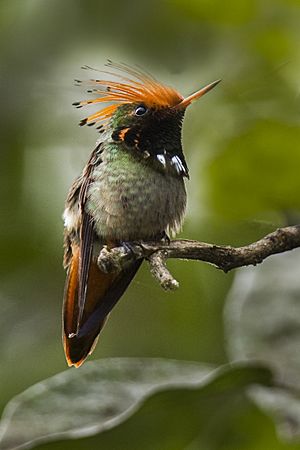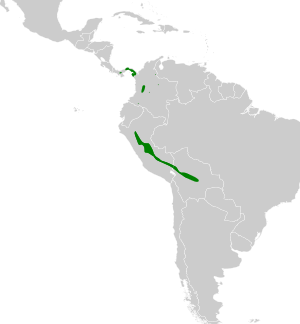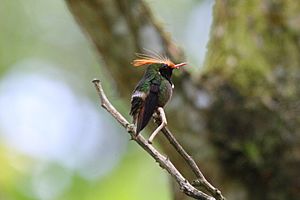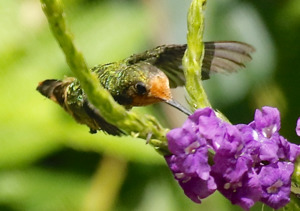Rufous-crested coquette facts for kids
Quick facts for kids Rufous-crested coquette |
|
|---|---|
 |
|
| Conservation status | |
| Scientific classification | |
| Genus: |
Lophornis
|
| Species: |
delattrei
|
 |
|
The rufous-crested coquette (Lophornis delattrei) is a type of hummingbird that lives in the warm, tropical areas of western South America. Because it is very small and there aren't many of them, it's quite rare to see one, even where they live. Male coquettes are easy to spot because of their amazing spiky, reddish-brown crests. Female coquettes are less flashy but can be identified by their small size and reddish-brown foreheads.

Contents
About the Rufous-Crested Coquette
The rufous-crested coquette is a bird in the Trochilidae family, which includes all living hummingbirds. It belongs to the Lophornis group, first described by a French scientist named René Lesson in 1829. This group includes many tiny hummingbirds found across Central and South America. Lesson identified the rufous-crested coquette in 1839. Scientists believe it is closely related to the tufted coquette.
Are There Different Types of Coquettes?
There is another very similar coquette that lives only in a small part of Guerrero, Mexico. Scientists don't fully agree on how to classify this bird. Some ornithologists (bird scientists) consider it a separate species called Lophornis brachylophus. Others think it's a subspecies of the rufous-crested coquette, known as L. d. brachylopha.
What Does a Rufous-Crested Coquette Look Like?
Rufous-crested coquettes are tiny birds, usually about 6.4 to 7.0 centimeters (2.5 to 2.8 inches) long. Their wingspan is about 4.0 to 4.5 centimeters (1.6 to 1.8 inches), and they weigh around 2.8 grams (about the weight of two paper clips!).
They have a short, orange beak that ends in a sharp, black tip. Their back and belly are a shiny, iridescent green. A white feather band crosses their lower back, and their tail feathers, which are brown, orange, and green, stick out from there.
Male Coquettes
Adult male coquettes have a crest of thin, stiff, reddish-brown feathers with black tips. These feathers grow upwards from their reddish-brown heads. Their throats are a darker, shiny green, ending in small, pointed white feathers. A vertical band of reddish-brown feathers frames the green throat and tail feathers. The male's tail has a double-rounded shape.
Female Coquettes
Female rufous-crested coquettes look similar to males but have some key differences. Females do not have a head crest. Instead, their reddish-brown forehead feathers blend into the shiny green feathers that go down their backs. Their throats are mostly white with small patches of green feathers. A band of reddish-brown feathers extends from the side of their throat all the way up to their forehead. The female's tail is singly rounded, and while mostly green, the tail feathers end with small patches of light orange.
How Do Rufous-Crested Coquettes Behave?
Foraging and Food
These hummingbirds mostly look for food in areas with fewer trees and low-growing flowering plants. They eat nectar from flowers found in humid evergreen forests, especially in clearings, open forest areas, and along roadsides. They particularly like the small white flowers of trees and shrubs from the Inga family, as well as plants from the Myrtaceae and Verbenaceae families. They also catch small insects by "hawking," which means they fly out to catch insects in mid-air. Because coquette hummingbirds are so small, they can't easily compete with other hummingbird species for food. This means they have to fly over larger areas to find enough to eat.
Reproduction and Life Cycle
Scientists have not yet seen rufous-crested coquettes mating or laying eggs. However, they likely have a similar courtship ritual to other coquette species. This ritual involves the male flying back and forth in front of a female perched on a branch, showing off his crest.
Flight Style
Coquette hummingbirds have a unique way of flying: they pump their tails up and down vertically. This pumping motion makes them look a bit like insects, and they are often mistaken for sphinx moths, which live in similar places and are about the same size.
Vocalizations and Sounds
Rufous-crested coquettes are usually quiet. However, they have been heard making a sharp "tsip" sound when they are feeding on nectar. They also make soft chipping sounds. When they fly, their fast wingbeats create a quiet humming sound.
Where Do Rufous-Crested Coquettes Live?
This species lives on the Pacific and Caribbean mountain slopes of Peru, Bolivia, Colombia, Ecuador, Panama, and Costa Rica. There has also been at least one sighting in western Brazil. They are mostly found at altitudes between 500 meters (1,640 feet) and 1,900 meters (6,230 feet) above sea level. They probably live at higher altitudes when they are breeding and lower when they are not.
Rufous-crested coquettes prefer humid forests with evergreen (trees that keep their leaves all year) or semi-deciduous (trees that lose some leaves) trees. They travel long distances within these ecosystems to find suitable food. In one experiment with frilled coquettes, a genetically similar species, they were seen to travel ranges of up to 15 kilometers (9.3 miles).
Conservation Status
The rufous-crested coquette is rare, but its population seems to be stable. The IUCN Red List, which tracks the conservation status of species, lists this bird as "least concern." This means they are not currently at high risk of extinction. Even though losing habitats due to deforestation is a big problem for many bird species in South America, the rufous-crested coquette feeds in open areas and forest clearings, so it is less affected by this issue.
Images for kids
See also
 In Spanish: Coqueta crestirrufa para niños
In Spanish: Coqueta crestirrufa para niños




